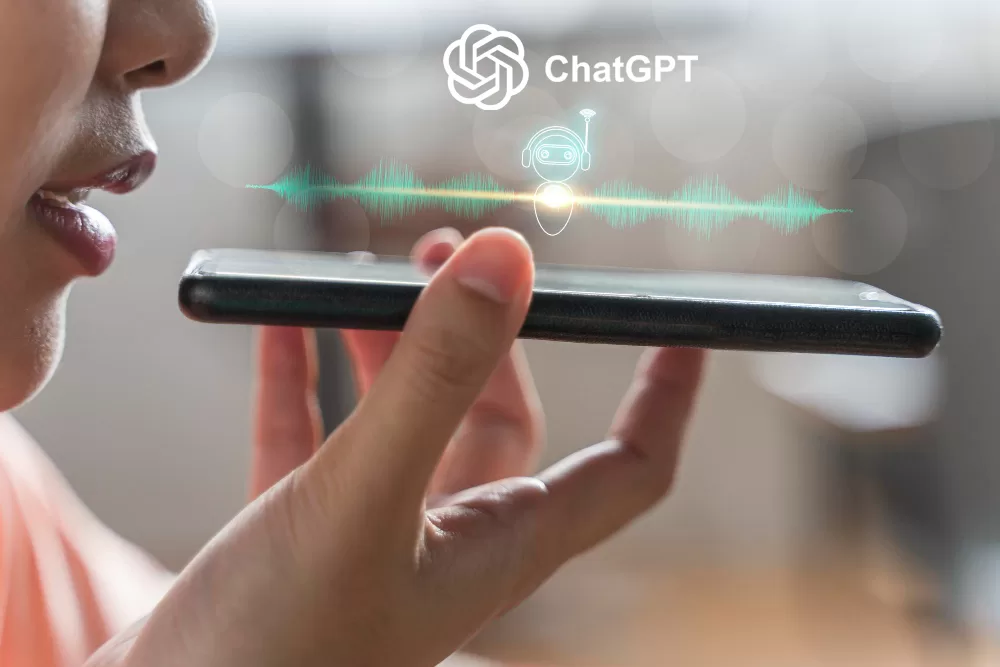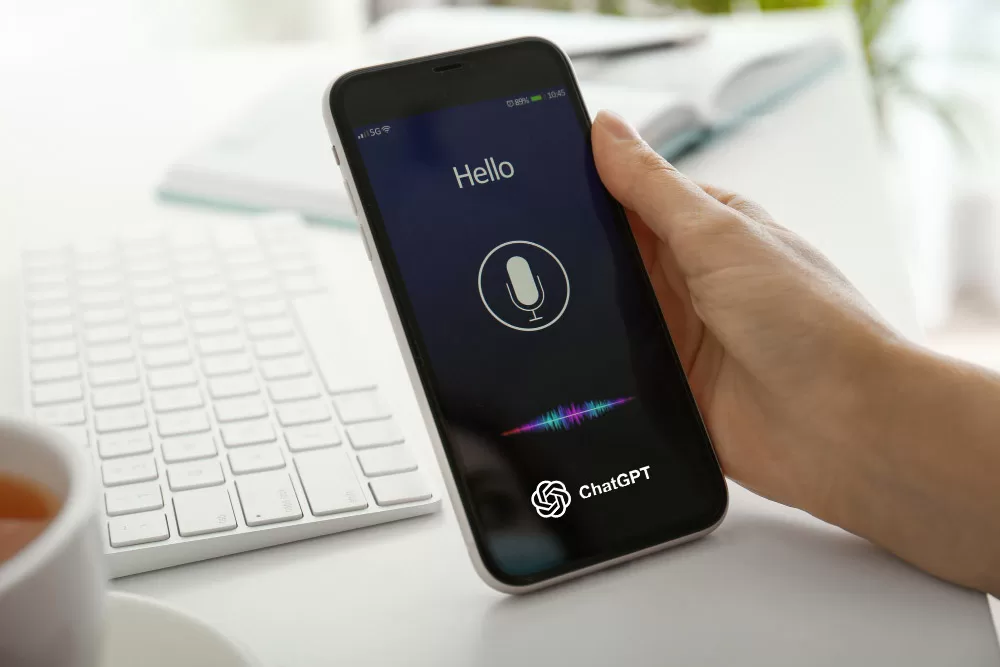
Spotlight
- How Does the Voice Chat Feature in ChatGPT Work?
- Step-by-Step Guide to Utilising the Voice Chat Feature
- Use Cases and Benefits of ChatGPT’s Voice Chat Feature
The rapid advancement of technology allows us to communicate with machines in new and exciting ways. One such breakthrough is the voice chat feature in ChatGPT, an AI-powered language model created by OpenAI. This feature enables users to have interactive conversations with ChatGPT using their voices, opening up a world of possibilities for communication and collaboration.
This article will examine the voice chat feature in ChatGPT, explaining how it functions, the advantages it provides, and most importantly, how to use it to improve your ChatGPT experience. Let’s get started!
What is ChatGPT?
Before we proceed further into the voice chat feature, let’s take a moment to understand what ChatGPT is. ChatGPT is a language model developed by OpenAI, designed to generate human-like text responses based on the given input. It leverages advanced machine-learning techniques to understand and respond to user queries, making it a powerful tool for various applications, including content creation, customer support, and language learning.
The Voice Chat Feature in ChatGPT
How Does the Voice Chat Feature Work?
Imagine you’re talking to a friend. Your friend listens to what you say and then responds with their thoughts or ideas. That’s essentially how ChatGPT’s voice chat feature works.
- You speak: When you speak into your microphone, ChatGPT’s voice recognition technology converts your spoken words into text.
- ChatGPT understands: ChatGPT’s natural language processing (NLP) technology then analyzes the text to understand what you’re saying.
- ChatGPT responds: ChatGPT uses its knowledge and understanding of language to generate a response, which it then converts back into text and sends to your audio output device (e.g., headphones, speakers).
In short, ChatGPT’s voice chat feature allows you to have a natural and intuitive conversation with the AI model, just like you would with a human friend.
ChatGPT’s voice chat feature makes it easy to interact with the AI just like you would with a friend. You speak into your device’s microphone, and ChatGPT listens, processes your words, and responds in real-time, creating a smooth and natural conversational experience.
Benefits of Using the Voice Chat Feature
Using voice chat in ChatGPT has some great perks. It makes talking with the model feel more natural, just like having a real conversation. This way of chatting can make the whole experience more enjoyable and smoother when you’re interacting with ChatGPT.
Voice chat in ChatGPT lets users talk without needing to type. This hands-free option means you can do other things while still getting instant replies. It’s handy for people who might find it hard to move around a lot or those who just prefer an easier way to chat.
The voice chat feature in ChatGPT is great for people who struggle with typing or have trouble seeing the screen. With voice commands, they can use ChatGPT without needing to type, making it more accessible and user-friendly.
How to Utilize the Voice Chat Feature in ChatGPT
Now that we understand the benefits of the voice chat feature, let’s explore how to utilize it effectively. By following these simple steps, you can begin having engaging and dynamic conversations with ChatGPT using your voice.
Step 1: Accessing the Voice Chat Feature
To access the voice chat feature in ChatGPT, you need to have a compatible device, such as a computer or smartphone, with a functioning microphone. Visit the ChatGPT website or open the ChatGPT app on your device to get started.
Step 2: Enabling Microphone Access
Before initiating a voice chat, ensure that your device’s microphone access is enabled. This can usually be done through the device’s settings or by granting permission when prompted by the ChatGPT interface.
Step 3: Initiating a Voice Chat
Once your microphone access is enabled, you can initiate a voice chat by clicking on the designated microphone icon within the ChatGPT interface. This will activate the voice chat feature and prepare the model to receive your voice commands.
Step 4: Interacting with ChatGPT via Voice
Once the voice chat is activated, you can start interacting with ChatGPT using your voice. Simply speak your queries or statements clearly and concisely, allowing the model to process your input and generate relevant responses. ChatGPT will deliver the textual responses in real time, creating a seamless conversational experience.
Tips for an Enhanced Voice Chat Experience

To make the most out of your voice chat experience with ChatGPT, consider the following tips:
Speak Clearly and Concisely:
When you use voice chat with ChatGPT, speaking clearly and not too quickly helps the model understand your commands accurately. By doing so, you ensure that the responses ChatGPT generates are precise and relevant to what you’re asking or saying. Clarity in speech makes the conversation smoother and minimizes any chances of misinterpretation, allowing for a more effective and enjoyable interaction.
Use Natural Language and Tone:
When you’re chatting with ChatGPT using voice, keeping your language natural and conversational brings a human touch to the conversation. It’s like talking to a friend! Using everyday language and a casual tone makes the interaction feel more genuine and relatable. Plus, it helps the model better understand your queries or prompts, ensuring that the responses you get are on point and easy to engage with. This natural flow in communication creates a more comfortable and enjoyable experience overall.
Provide Clear Instructions:
Offering clear instructions is key to getting the best out of your interactions with ChatGPT. When you’re specific and provide context, it’s like giving the model a roadmap to follow. This clarity ensures that ChatGPT understands precisely what you’re looking for or the guidance you need. The more details you give, the better ChatGPT can tailor its responses to meet your needs or provide accurate information. It’s like making sure you’re both on the same page, which results in more helpful and relevant answers.
Be Patient and Allow Processing Time:
Being patient during interactions with ChatGPT is essential. Just like any conversation, it takes a moment for the model to process the information you provide and generate a thoughtful response. Avoid interrupting or speaking over ChatGPT, as it needs time to understand your query fully. Patience ensures that the model has enough space to consider your input and provide the most accurate and relevant response possible. It’s like giving ChatGPT the breathing room it needs to work its magic and offer you the best insights or information you’re seeking.
By following these tips, you can enhance your voice chat experience and have more productive and satisfying interactions with ChatGPT.
Use Cases for the Voice Chat Feature
The voice chat feature in ChatGPT opens up a wide range of use cases across various industries and domains. Here are a few examples of how this feature can be leveraged:
Virtual Assistants and Customer Support
With the voice chat feature, virtual assistants and customer support systems can offer more personalized and interactive experiences. Users can speak their queries or concerns, and ChatGPT can provide real-time assistance, guiding them through various processes or addressing their concerns.
Language Learning and Practice
Language learners can benefit greatly from the voice chat feature in ChatGPT. By engaging in conversation with the model, learners can practice their speaking skills, receive instant feedback, and improve their fluency and pronunciation.
Content Creation and Writing Assistance
Writers and content creators can leverage the voice chat feature to brainstorm ideas, receive suggestions, and get real-time feedback on their work. This can enhance the creative process and provide valuable insights to improve the quality of their content.
Bottomline
The voice chat feature in ChatGPT changes how we engage with AI language models. It allows users to talk to ChatGPT using their voice, creating a more natural and engaging conversation. Whether you need help, want to practice a language, or seek creative ideas, using voice chat can make your interactions with ChatGPT better and open up new opportunities for you.
So, why not explore the voice chat feature in ChatGPT today and experience the future of communication firsthand?
FAQs
1: Can I use the voice chat feature on my mobile device?
Yes, ChatGPT’s voice chat feature is compatible with mobile devices that have a functioning microphone. Simply visit the ChatGPT website or download the ChatGPT app to get started.
2: Is the voice chat feature available in multiple languages?
Currently, ChatGPT’s voice chat feature primarily supports English. However, OpenAI is actively working on expanding language support to cater to a wider user base in the future.
3: Can I use the voice chat feature offline?
No, the voice chat feature in ChatGPT requires an internet connection to function. It relies on cloud-based services to process voice inputs and generate textual responses in real-time.
4: Are there any limitations to the voice chat feature?
While the voice chat feature in ChatGPT offers an impressive conversational experience, it may occasionally encounter limitations or generate inaccurate responses. OpenAI is continuously working to improve the model’s performance and address any limitations or biases that may arise.
Remember, the voice chat feature is an evolving technology, and user feedback plays a crucial role in its refinement and development. So, don’t hesitate to provide feedback and suggestions to OpenAI to contribute to the advancement of this groundbreaking feature.



